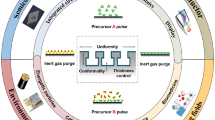Abstract
Silicon is one of many materials whose surface will oxidize in ambient conditions. However it is one of few materials whose native oxide will self-limit its growth in a matter of hours at a thickness of ∼2 nm. In this work, we show through the theory of repulsive van der Waals forces that this self-limitation is due, at least in part, to the interaction between the inherent material properties of a native silicon oxide film on silicon and oxidizing molecules. These molecules are not just hindered from even entering the system at all, but those that do enter the native oxide film are repelled away from the silicon – silicon oxide interface, preventing additional growth by oxidation. We also show how this repulsion is overcome by increasing ambient temperatures to subsequently increase the kinetic energy of the oxidizing molecules, calculated by the Boltzmann-Maxwell distribution, and allow oxidation to continue.
Similar content being viewed by others
References
Raider SI, Flitsch R, Palmer MJ (1975) Oxide growth on etched silicon in air at room temperature. J Electrochem Soc 122:413–418
Morita M, Ohmi T, Hasegawa E, et al. (1990) Growth of native oxide on a silicon surface. J Appl Phys 68:1272–1281. doi:10.1063/1.347181
Kakiuchi H, Ohmi H, Harada M, et al. (2007) Formation of silicon dioxide layers at low temperatures (150–400 °C) by atmospheric pressure plasma oxidation of silicon. Sci Technol Adv Mater 8:137–141. doi:10.1016/j.stam.2006.12.006
Deal BE, Grove AS (1965) General relationship for the thermal oxidation of silicon. J Appl Phys 36:3770. doi:10.1063/1.1713945
Ligenza JR (1965) Silicon oxidation in an oxygen plasma excited by microwaves. J Appl Phys 36:2703. doi:10.1063/1.1714565
Pliskin WA, Lehman HS (1965) Structural evaluation of silicon oxide films. J Electrochem Soc 112:1013–1019
Deal BE (1963) The oxidation of silicon in dry oxygen, wet oxygen, and steam. J Electrochem Soc 110:527– 533
Kazor A, Boyd IW (1993) Ozone-induced rapid low temperature oxidation of silicon. Appl Phys Lett 63:2517–2519. doi:10.1063/1.110467
Cui Z, Madsen JM, Takoudis CG (2000) Rapid thermal oxidation of silicon in ozone. J Appl Phys 87:8181–8186. doi:10.1063/1.373515
Xu J, Choyke WJ, Yates JT (1997) Enhanced silicon oxide film growth on Si (100) using electron impact. J Appl Phys 82:6289. doi:10.1063/1.366516
Cabrera N, Mott NF (1949) Theory of the oxidation of metals. Reports Prog Phys 12:163–184
Engel T (1993) The interaction of molecular and atomic oxygen with Si(100) and Si(111). Surf Sci Rep 18:91–144
Hamaker HC (1937) The London-van der Waals attraction between spherical particles. Phys IV 10
Lifshitz EM (1955) The theory of molecular attractive forces between solids. J Exp Theor Phys 29:94–110
Parsegian VA, Ninham BW (1970) Temperature dependent van der Waals forces. Biophys J 10:664–674
Hough D, White L (1980) The calculation of hamaker constants from liftshitz theory with applications to wetting phenomena. Adv Colloid Interface Sci 14:3–41
Tabor D, Winterton RHS (1969) The direct measurement of normal and retarded van der Waals forces. Proc R Soc A Math Phys Eng Sci 312:435–450. doi:10.1098/rspa.1969.0169
Bohling CD, Sigmund WM (2014) Predicting and measuring repulsive van der Waals forces for a Teflon AFTM - solvent-- α-alumina system. Colloids Surfaces A Physicochem Eng Asp 462:137–146. doi:10.1016/j.colsurfa.2014.08.018
Woan KV, Sigmund WM (2011) Force interactions of porous silica glass microspheres against mirror-polished stainless steel in nonaqueous solvents. Langmuir 27:5377–85. doi:10.1021/la200157v
Lee S, Sigmund WM (2002) AFM study of repulsive van der Waals Forces between Teflon AFTM thin films and silica or alumina. Colloids Surfaces A Physicochem Eng Asp 204:43–50
Lee S, Sigmund W (2001) Repulsive van der Waals forces for silica and alumina. J Colloid Interface Sci 243:365–369. doi:10.1006/jcis.2001.7901
Feiler A, Bergström L, Rutland M (2008) Superlubricity using repulsive van der Waals forces. Langmuir 24:2274–6. doi:10.1021/la7036907
Munday JN, Capasso F, Parsegian VA (2009) Measured long-trange repulsive Casimir-Lifshitz forces. Nature 457:170–3. doi:10.1038/nature07610
Milling A, Mulvaney P, Larson I (1996) Direct measurement of repulsive van der Waals interactions using an atomic force microscope. J Colloid Interface Sci 180:460–465
Bowen WR, Hilal N, Lovitt RW, Wright CJ (1999) An atomic force microscopy study of the adhesion of a silica sphere to a silica surface - effects of surface cleaning. Colloids Surfaces A Physicochem Eng Asp 157:117–125. doi:10.1016/S0927-7757(99)00045-X
Meurk A, Luckham PF, Bergström L (1997) Direct measurement of repulsive and attractive van der Waals forces between inorganic materials. Langmuir 13:3896–3899
Matope S, Rabinovich YI, Van der Merwe AF (2012) Van der Waals interactions between silica spheres and metallic thin films created by e-beam evaporation. Colloids Surfaces A Physicochem Eng Asp 411:87–93. doi:10.1016/j.colsurfa.2012.07.006
Bohling C, Sigmund W (2015) Repulsive van der Waals forces self-limit native oxide growth. Langmuir. (In Press)
Israelachvili JN (1992) Intermolecular and surface forces, 2nd Ed. Academic, San Diego
Kalnitsky A, Tay SP, Ellul JP, et al. (1990) Measurements and modeling of thin silicon dioxide films on silicon. J Electrochem Soc 137:234–238
Author information
Authors and Affiliations
Corresponding author
Rights and permissions
About this article
Cite this article
Bohling, C., Sigmund, W. Self-Limitation of Native Oxides Explained. Silicon 8, 339–343 (2016). https://doi.org/10.1007/s12633-015-9366-8
Received:
Accepted:
Published:
Issue Date:
DOI: https://doi.org/10.1007/s12633-015-9366-8




